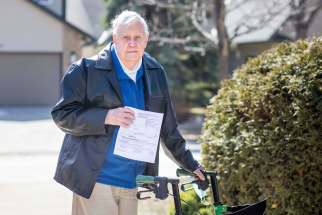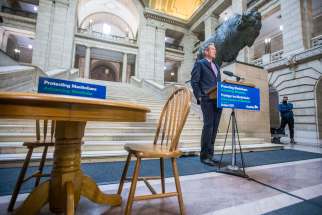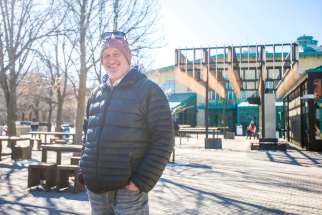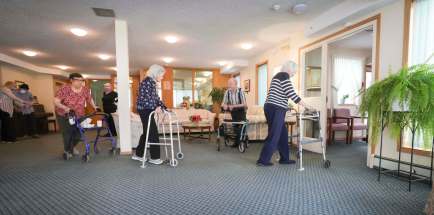Oral history Dental trailblazer opens up about distinguished career
Read this article for free:
or
Already have an account? Log in here »
To continue reading, please subscribe:
Monthly Digital Subscription
$0 for the first 4 weeks*
- Enjoy unlimited reading on winnipegfreepress.com
- Read the E-Edition, our digital replica newspaper
- Access News Break, our award-winning app
- Play interactive puzzles
*No charge for 4 weeks then price increases to the regular rate of $19.00 plus GST every four weeks. Offer available to new and qualified returning subscribers only. Cancel any time.
Monthly Digital Subscription
$4.75/week*
- Enjoy unlimited reading on winnipegfreepress.com
- Read the E-Edition, our digital replica newspaper
- Access News Break, our award-winning app
- Play interactive puzzles
*Billed as $19 plus GST every four weeks. Cancel any time.
To continue reading, please subscribe:
Add Free Press access to your Brandon Sun subscription for only an additional
$1 for the first 4 weeks*
*Your next subscription payment will increase by $1.00 and you will be charged $16.99 plus GST for four weeks. After four weeks, your payment will increase to $23.99 plus GST every four weeks.
Read unlimited articles for free today:
or
Already have an account? Log in here »
Hey there, time traveller!
This article was published 01/04/2021 (1718 days ago), so information in it may no longer be current.
Some stories take longer to get around to than others.
In the fall of 2011 I hooked up with Fiona Odlum at an Academy Road Starbucks for a lighthearted feature about people who report on traffic for a living. Odlum, currently a contributor at CBC Saskatchewan, was working for 680 CJOB at the time, clueing rush-hour commuters in on stalls, lane closures and fender-benders they’d be wise to avoid.
Odlum turned the tables at one point by asking a few questions of her own including, “So, what’s your main beat?”
I don’t really have one, I told her, but if pressed, I would probably go with human-interest pieces.
She said in that case I should interview her Welsh-born mother, who became the first woman to practise dentistry in Manitoba when she moved to Winnipeg from the United Kingdom via British Columbia in 1967.
“Hmm, that does sound interesting,” I remarked.

Skip ahead to December 2020; at home on the couch, I’m semi-paying attention to the supper-hour news when the anchor tells us to stay tuned, up next is a story about retired medical specialists who are signing up to help administer the COVID-19 vaccine. A moment later, following a commercial informing us where to “c’mon down” for our next furniture or appliance purchase, a reporter is speaking with Dr. Olva Odlum, a retired dentist who has announced she’s ready, willing and able to do whatever it takes to assist Manitobans.
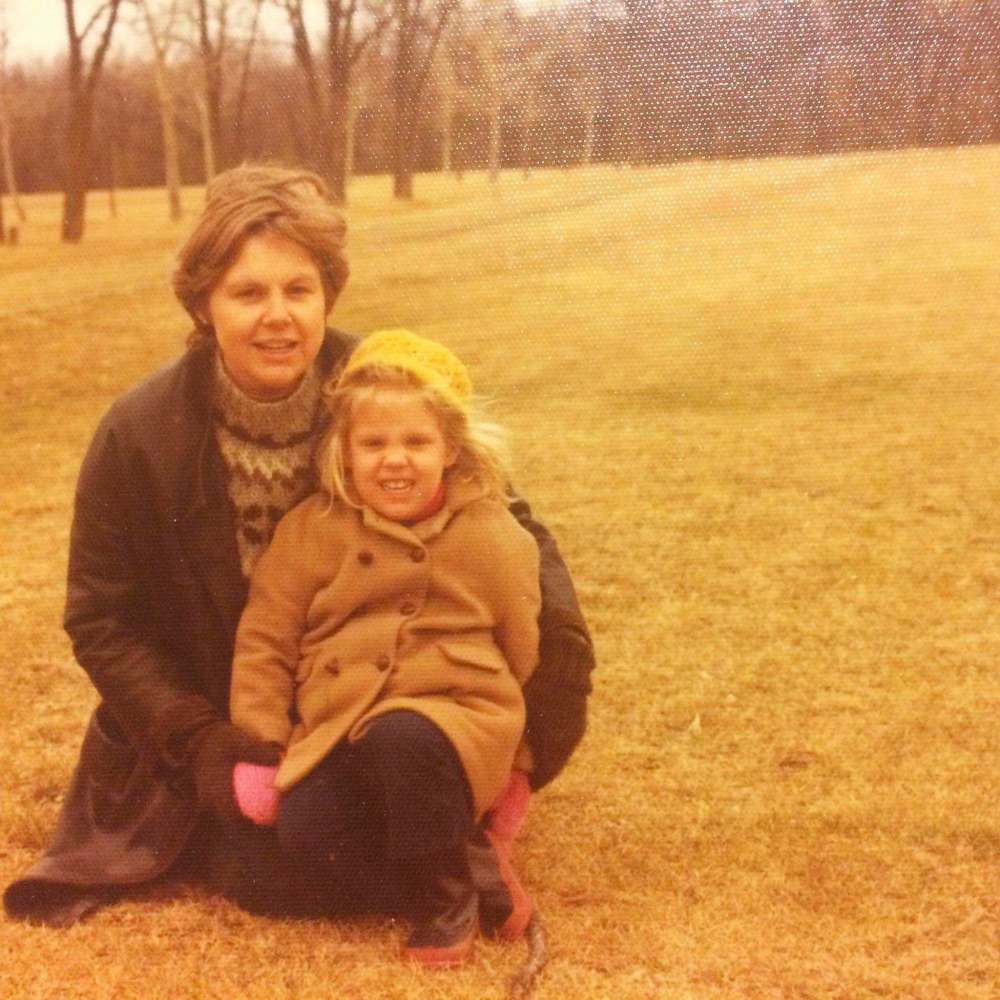
Wait, is that the same Dr. Odlum I was told about however many years ago, I wondered aloud?
A few days later, after reaching out to Fiona Odlum through social media, I learn, yep, that’s “her,” all right. I learn also that she’d be pleased to share the story of her long and distinguished career that, as I would soon learn, has all the makings of a PBS mini-series.
● ● ●
“OK, how do you want this thing to start?” Dr. Olva Odlum asks a few days later, instructing us to take a seat in the Osborne Village condo she’s rented since October. Ordinarily Odlum, 81, lives on a 10-acre property near Fraserwood, west of Gimli. But after Bruce Odlum, her husband of 56 years, died in February 2020, her two daughters, Fiona, who currently resides in Regina, and Annabelle Clendenan, who calls Sydenham, England, home, insisted she get a place “in the city,” at least until the snow melts.

Odlum, who received her first vaccination shot at an immunization supersite in Selkirk in late March, confirms she’s been in touch with the province to offer her services, if and when they’re needed. What’s more, she hopes by speaking publicly about the vaccination process it will encourage people in her rural neck of the woods to follow her lead by rolling up their sleeves, too.
After she appeared on the news, she would be back home grabbing some groceries only to have her neighbours approach her and say, “Olva, we saw you on TV talking about how you’re getting the shot. Is that something we should be doing, too?”
“You see, not everybody living in the country spends a lot of time online so all this vaccine information the government is putting forward isn’t necessarily getting through,” says Odlum, nominated in January for a Nellie McClung Foundation Manitoba Women Trailblazer award. “So yes, I’d be fine (pretends to jab herself in the arm with a needle) but I also told them I’d happily be on-site to answer any questions people showing up might have. I’ve been answering questions most of my life — for a while, of course, it was primarily, ‘Who the hell are you?’ followed by ‘Where’s the goddamn dentist?’ — so I don’t see any reason to stop now.”
● ● ●
Odlum (née Jones), the younger of two siblings, grew up in southwestern Wales near Llanelli, a town of about 50,000 residents. She spoke strictly Welsh until high school when she was forced to learn English, “a real problem,” she says pursing her lips.
Science was always her favourite subject at school — she thought nothing of dissecting frogs and small rodents — so her parents weren’t taken aback when she let them know she intended to become a doctor. Her “mam” Gwladys wasn’t convinced it was the best decision but her dad Gwilym, whom she describes as incredibly easygoing, said if that’s what she wanted, she should go ahead and do it.
The principal at the all-girls school she attended was less supportive. “Medical school? You’ll never get in,” she said when Odlum revealed her plans.
“OK, then. What about dental school?” Odlum retorted.
“Now you’re on to something,” came the reply. (It wasn’t until 40 years later that Odlum learned the British government had passed an edict in 1957 to accept more women in dental school, a fact her principal neglected to mention.)

Odlum moved to London in 1958 to study at the Royal Dental Hospital, now closed. It was an amazing place, she says, her eyes lighting up, located in the heart of the city’s entertainment district, steps away from Piccadilly Circus.
“We used to get free tickets to many, many plays. Instead of having empty seats in the theatre the people in charge of sales would bring tickets to school to hand out to the guys in class who would turn around and convince one of us girls to go with them,” she says, recalling she once saw Sir Alec Guinness onstage, back when the Academy Award winner was already a top box-office draw in Britain.
Odlum graduated in 1962. It didn’t take long until she landed a “very, very prestigious” job in the oral surgery unit at St. Bartholomew’s Hospital, the oldest medical facility in London, founded in 1123. She primarily worked nights and was kept hopping attending to rough-and-tumble characters who’d stumble in bleeding from the mouth owing to a dust-up after a pint too many.
“Sometimes they’d be brought in unconscious and would wake up to me ripping out their broken teeth, at which point they’d be, ‘hey, what the f—,’” she says with a laugh. “It was a wild time, true, but after a while I asked myself, did I really want to work on drunks for the next five years? My answer was no. This was when my life really changed.”
● ● ●
Before seeking a new position Odlum returned to Wales to spend time with family. A few days into her visit she embarked on a side trip to Fishguard, a coastal village where many of her ancestors come from. On her second day there she was preparing to board a sightseeing bus when a chap in his early 20s nodded hello and inquired where she was headed.
After a bit of back and forth he asked if she planned to return later that day. Yes, she told him, her hotel room was booked for another night. Perfect, he said; in that case she should join him and his buddies for drinks at a pub right around the corner.
“I wouldn’t do it today… I don’t think,” she says with a wink, “but that night he came and picked me up at my hotel, and off we headed to meet his friends.”
During the course of the evening the conversation turned to what everybody did for a living. The second Odlum announced she was a dentist one of her new companions said it just so happened he lived in an apartment above a dental clinic, and that the person in charge was desperate for an assistant given he preferred working one day a week. That’s interesting, Odlum said not really meaning it, stressing her aim was to find work in London.
“To make a long story short, I went back (to London) but these guys kept ringing me in an attempt to convince me to return to Wales to work for this Dr. Davis. Finally I thought, what the heck. Why not? So I packed my things and went to see him at his clinic. Though to call it a clinic is a bit of an exaggeration. Primitive, shall we say?”
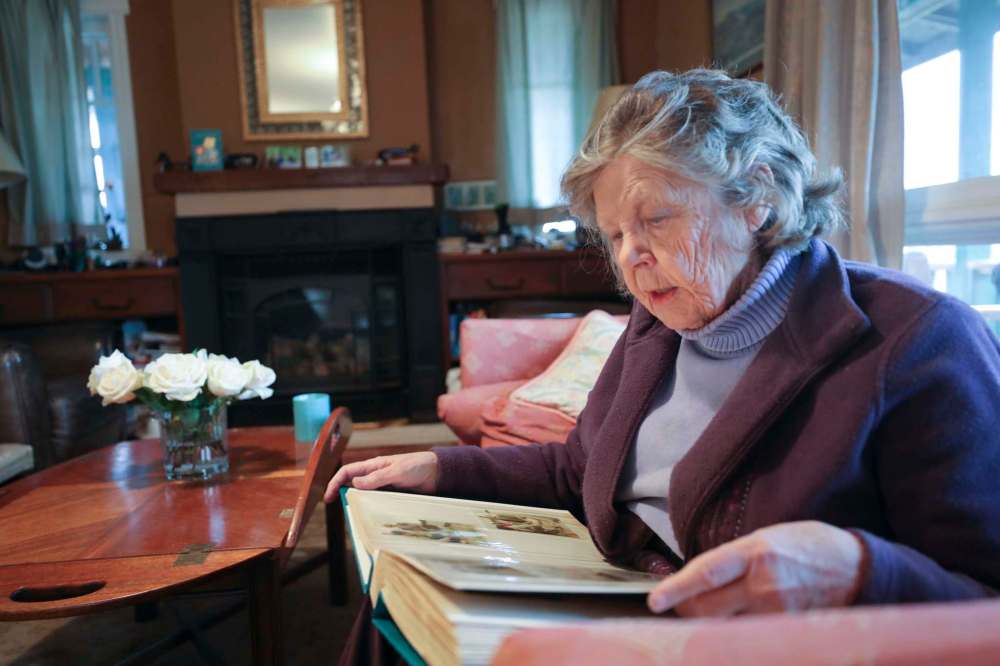
Odlum describes the next 10 months of her life practising dentistry in Fishguard as an “incredible experience.” She doubles over laughing, recalling the morning she called on a postmaster who lived 15 minutes outside town. He didn’t have access to a vehicle so wasn’t able to get to the clinic, he’d told her over the phone. She couldn’t believe her eyes when she walked through the front door and saw a crowd of people seated in the living room. It turned out they were his neighbours, none of whom had been to a dentist before and wanted to observe the goings-on.
“An older woman in an apron stepped forward, informing me she lived next door and was there to assist me,” she continues. “As it turned out, the person I’d come to see did need a couple of teeth extracted. While I was giving him a needle, everybody leaned forward to get a better look, all of them going ‘ooh’ and ‘aww.’ When I finished, this other chap put up his hand asking if he could be next. Of course not, I said, nothing is sterilized. To which he replied he wasn’t fussy and I could simply run my tools under the tap for 30 seconds.”
Another time, she agreed to meet a man who had “three teeth in his head and one of them was loose” at his preferred location, a hotel bar. He insisted she join him in a drink before they got “to things.” Two shots of whisky later, one for each of them, she fetched her forceps and Bob’s your uncle, the job was done.
By the way, that person she met when she was boarding a bus her first day in Fishguard, the one who came round for her later that evening? That was Bruce Odlum. The two of them were married in 1964 in an ancient church in Nevern, a village in the county of Pembrokeshire.
● ● ●
The Odlums moved to the English county of Somerset after tying the knot. She went to work for a public health agency while he, with a background in agriculture, got a job managing a countryside farm. Olva was leafing through the London Times one morning when she spotted a full-page advertisement inviting doctors, dentists and teachers to emigrate to Canada, where there was a shortage of professionals.
A girlfriend of hers from dental school had moved to Vancouver — the two regularly traded letters — so Olva suggested to Bruce they follow suit. He pooh-poohed the idea, at least until she fetched an atlas to show him where Vancouver was situated exactly. “Hmm, looks like it’s on the Pacific. It must be nice and warm,” he said.
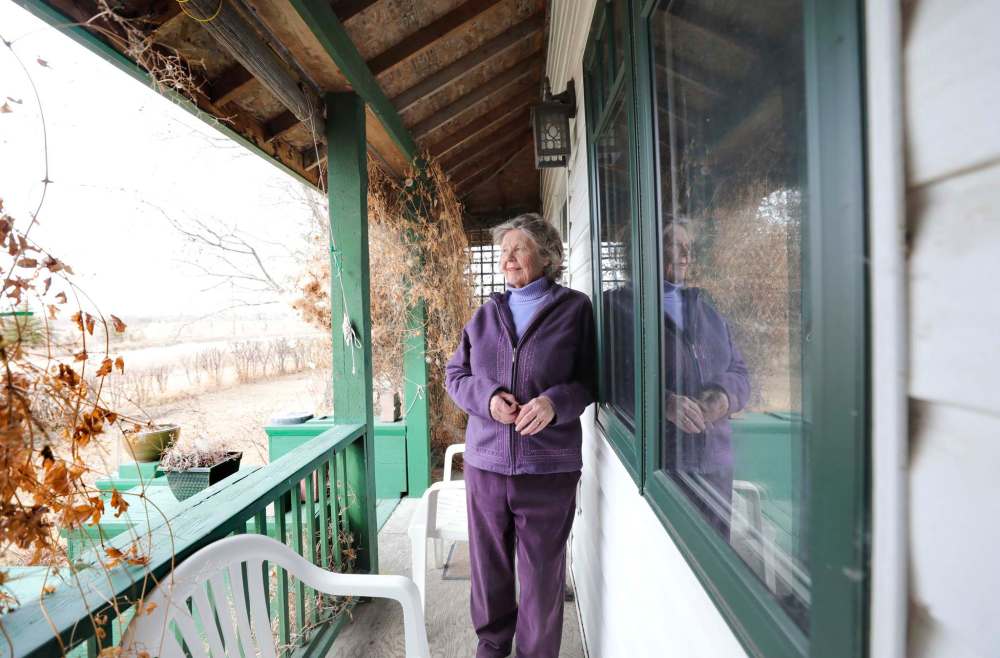
They made their way to London the following week to fill out the necessary documents. She still isn’t 100 per cent sure why they were accepted; she likes to think it was because of her dental skills, but she also remembers how excited the person who helped them fill out the forms became after he mentioned he had a dear friend in B.C. with the surname Odlum, and Bruce flat-out fibbed, stating, “Why, that’s my cousin!”
Ten months after arriving in Vancouver, where she landed a dentist’s job in a veteran’s hospital, they were on the move again; this time to Dawson Creek, in the northeastern part of the province, where Bruce had been hired to manage a farm.
Their first day there, her husband’s new boss dropped by where they were going to be living to introduce himself. As he was about to leave he turned to her and said, “What about you? What do you do?” She told him she was a dentist. “Hang on,” he said, reaching for the phone.
“I have a woman here who says she’s a dentist, who’s sitting on her ass doing nothing,” he told the person at the other end of the line. “What’s that? Can she start at nine tomorrow? I’ll ask her.”
Just like that, she had a new job.
“So there we were in Dawson Creek, having an absolutely wonderful summer,” she says, noting she was kept busy attending to young men who were building a dam on the Peace River, who would come into town every weekend with wallets full of cash, wanting their teeth fixed.
“After the crop got put in, however, there was no more work for Bruce to do. He applied for a job with one of the grain companies — at this point we had a baby, Annabelle — and the next thing we knew he got a call to report to the head office in a strange-sounding place called… Winnipeg.”
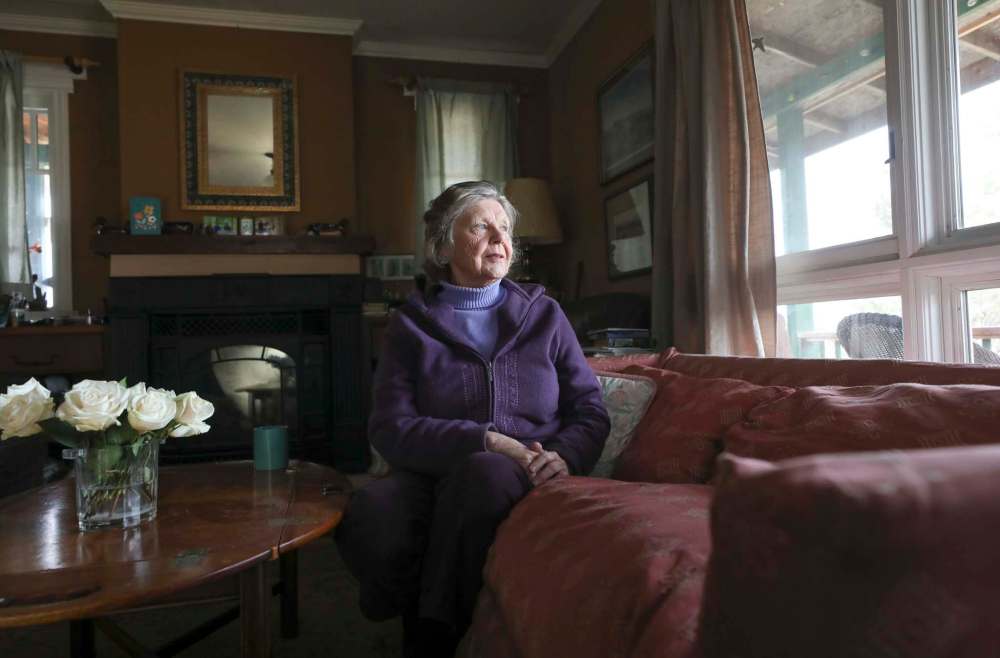
The Odlums arrived in Winnipeg in the fall of 1967, settling into a high-rise on Grant Avenue close to Stafford Street. While her services had been welcomed with open arms — and mouths — in British Columbia, it wasn’t the same story here initially.
She got in touch with the Manitoba Dental Commission and was informed she’d have to pass a written exam in order to get a licence to practise in the province. No problem, she said, when was the test? In two weeks’ time; only she wasn’t eligible, she was told.
Why not, she asked?
“Because I run the place and you have to apply six months in advance,” the person on the phone, “a grouchy SOB,” said.
“I thought, oh shit, now what am I going to do? Then I remembered; before I left Dawson Creek the guys I worked for said if I had any problems finding work when I got to Winnipeg I should get in touch with Cosmo Castaldi, a professor at the (University of Manitoba) dental school. I did just that, explaining my situation. To which he said, ‘Give me a couple of days, I’ll get back to you.’”
True to his word, Castaldi phoned her later that week with a proposal: if she was willing to take a job that paid $200 a week running a makeshift clinic in a condemned house across from the Health Sciences Centre that catered to what he referred to as the “most complicated children,” ones who were deaf, blind, suffering from hemophilia — the list went on and on — then he would ensure she was able to practise while waiting to write the test.
“What choice do I have?” she said.
“Good, meet me there tomorrow and I’ll show you around,” he replied.
Once she was fully accredited, Odlum spent three years at a clinic on Osborne Street, just down from the Park Theatre. In 1968 she was the subject of Winnipeg Tribune story that lauded her for having “a woman’s touch,” which directly led to an increase in patients. Not everybody was a fan of what the paper called, “Manitoba’s first woman dentist,” however. She was regularly required to attend lectures and recalls a dental association emcee mocking her presence, kicking things off with, “Good day, gentlemen … and I suppose good day to you, too, madam.”
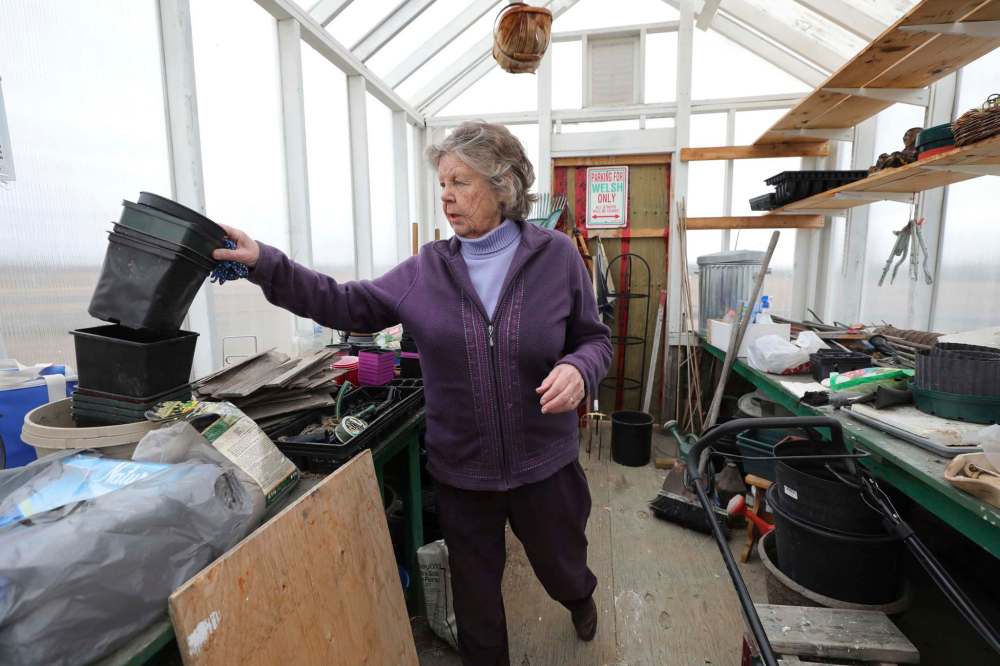
Annabelle Clendenan, Odlum’s eldest daughter, says she wishes that was the case when asked if, while growing up, she and her sister thought of their mother simply as mom, and not a pioneer in her field.
“No, she was never just mom. She worked exceptionally long hours and continued to study to keep abreast of new medical conditions and advances in scientific technologies,” Clendenan says when reached at home in England, where she’s lived since 1997 with her Winnipeg-born husband and their two adult children. “We knew my mother was doing something different when everyone — our teachers, the mailman, our friends’ parents — assumed our father was Dr. Odlum.”
Here’s something interesting; if you think a dentist’s daughter would never need to be reminded to floss and brush three times a day, think again.
“Yes, she did (remind us) though Mum is not a big advocate of flossing so she would only suggest it if food was stuck,” she goes on. “We could only drink 7-Up; would not stain our teeth. A bottle would be bought on Friday and once it was gone, it was gone. Then we would drink water and only water. We were told that a bit of cheese was an excellent late-night snack; she would rather our teeth be covered in calcium if we were to fall asleep before brushing our teeth.”
● ● ●
The Odlums hosted a Christmas party at their apartment overlooking Peanut Park in November 1972. Olva, on maternity leave with their second daughter, struck up a conversation with one of their guests, Cy Gonick, the NDP MLA for Crescentwood. Gonick asked if she had ever worked in a public health program. She replied affirmatively, first in Somerset and just the year before, when she had volunteered to work in Norway House for a month. In that case she might be just the person he was looking for, he said.
Odlum spent the next three years working for the ruling NDP government, providing guidance on a number of issues, one of which was ensuring standards at long-term care facilities in the province were up to par or, as she so eloquently puts it, “None of this, ‘sedate them, tie them to an armchair and give them some porridge.’”
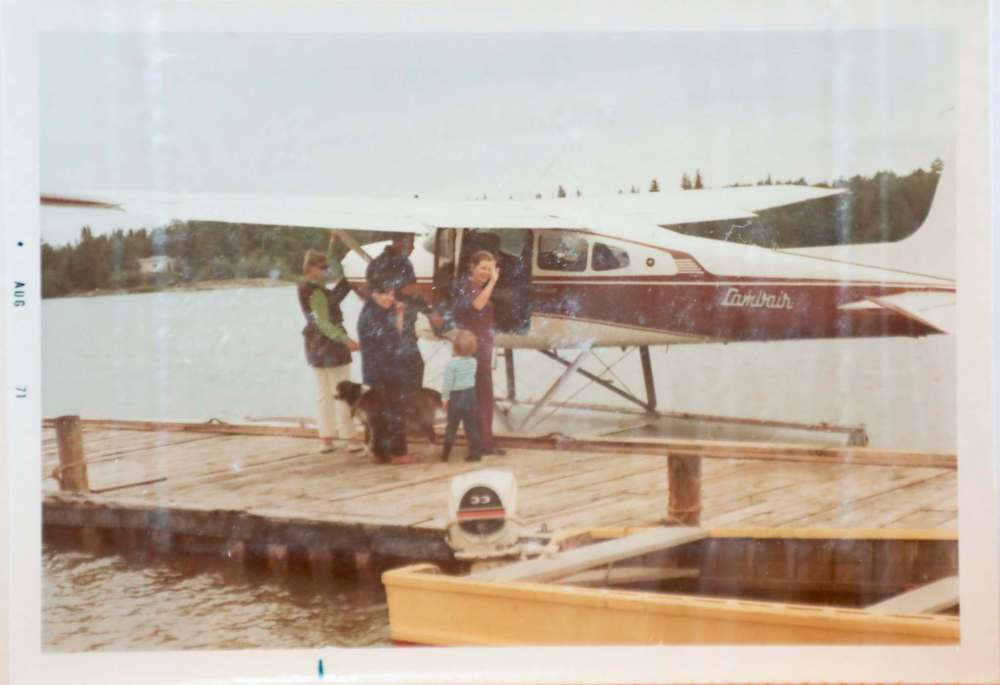
During that period she was also tasked with conducting an extensive study to determine if the dental needs of children living in rural parts of the province were being met or not. Her work in that regard led to an invitation to speak at the University of Manitoba, where the dental college, in concert with the provincial government, was preparing to introduce an externship program that would send fourth-year students to remote communities in Manitoba, locales that rarely, if ever, were visited by a dentist.
One of the instructors was so impressed by her presentation that he asked if she would consider helping get the program off the ground; only the way he phrased it was, “The dental school has been told it has to start a program in rural Manitoba and not only are you the only person who can chair this committee, you’re the only goddamn one who even knows where rural Manitoba is.”
“The [1975] class was all these Winnipeg princes, most of whom informed me in no uncertain terms they had no intention of going north. Fine, I told them, you don’t have to. And you don’t have to graduate either.”– Dr. Olva Odlum
Odlum, the first woman appointed to a full-time position with the Faculty of Dentistry, spent over two decades teaching at the U of M, where she acted as the Head of the Section of Community Dentistry.
She vividly recalls addressing the class of ‘75, the first set of students that would be required to head north for a week to offer their services where needed.
“The class was all these Winnipeg princes, most of whom informed me in no uncertain terms they had no intention of going north. Fine, I told them, you don’t have to. And you don’t have to graduate either,” she says.
Although many were initially hesitant to go, Odlum, who spent her summers practising in the north, often with Bruce in tow, instead of working at the university, says that first batch of naysayers had a sudden change of heart when their fellow classmates returned, and went on and on about their experience.
“We used to send them four at a time, two each to Churchill and Peguis. When they came back they would proudly display pictures they’d taken on a classroom bulletin board. The program ran for 26 years and I’m proud to say I was around for 22,” says Odlum, who also worked with the province during her days at the U of M to initiate a program for children born with a cleft palate, an order-of-business that was subsequently used as a model by the other nine provinces.
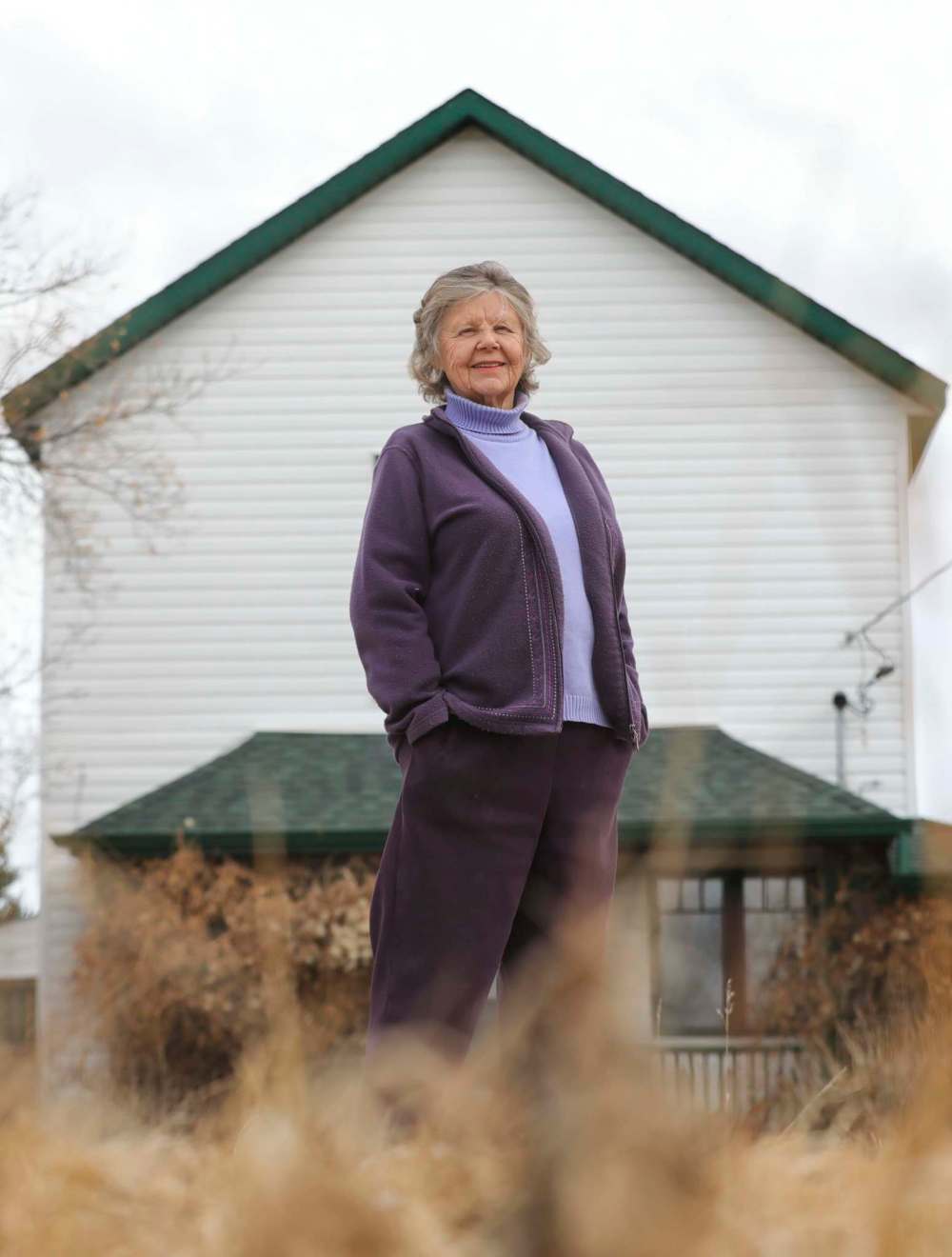
Dr. Anastasia Kelekis-Cholakis, dean of the Dr. Gerald Niznick College of Dentistry at the University of Manitoba, was a student of Odlum’s in 1988. She lived and worked in the north twice during her tenure there, once in Churchill and another time in Rankin Inlet.
“Personally speaking it was an amazing experience, all made possible because of Dr. Odlum’s hard work and perseverance,” she says over the phone. “The university had issues with its budget after she left and unfortunately the (externship) program was discontinued. But I would love to get it up and running again. One of my visions is to recreate it, to give that same experience we enjoyed to the next generation of dental students.”
Kelekis-Cholakis says for the first time ever in the history of the U of M, the majority of this year’s graduating class of dentists, close to 60 per cent, will be women. She adds that Odlum, currently listed as a senior scholar in the Department of Preventive Science, remains a role model for each and every one of them.
“I remember how nice it was when I was studying to have her as a teacher, one of only two female instructors we had at the time,” says Kelekis-Cholakis. “In fact, we’re getting together next week to chat about some ideas she wants to share with me. I’m always interested in what she has to say. She’s an absolute force of nature.”
● ● ●
Odlum worked at Health Sciences Centre, primarily with kidney transplant patients, following her academic career. The anti-rejection drugs in use at the time were causing oral issues for patients, and she got “caught up big-time” for several years helping solve those problems. One afternoon, she was walking to her car in the HSC parking lot when a doctor from the cancer ward stopped her to ask a question; was it true they should be removing the teeth of people scheduled for radiation treatment. “Are you guys nuts?” she shot back. For the rest of her time there she worked extensively with cancer patients, as well.
She was preparing to retire in the early 2000s — her last day of work, three months away, had been circled on the calendar — when she was approached yet again, this time to do cancer-related analysis at the National Research Council of Canada’s headquarters on Ellice Avenue. She initially said no — she and Bruce had a “wonderful life” planned; they were going to move to Fraserwood and spend the bulk of their time gardening – but in the end she relented, working three more years assisting people suffering from cancer of the mouth, throat and neck.
Then came what she laughingly refers to as her “final hurrah.” Seven years ago a dental clinic was set to open in Norway House. The problem was, the dentist who was supposed to run it couldn’t go all of a sudden. A government official who knew Odlum from the U of M reached out, asking if could she could spend a month there to get things up and running. She told them the most she could offer was two weeks; spring was right around the corner and she needed to get the garden in. As you may have guessed, it was another 18 months before Odlum, who flew back and forth to Norway House on a near-weekly basis during that period, put her feet up for good.
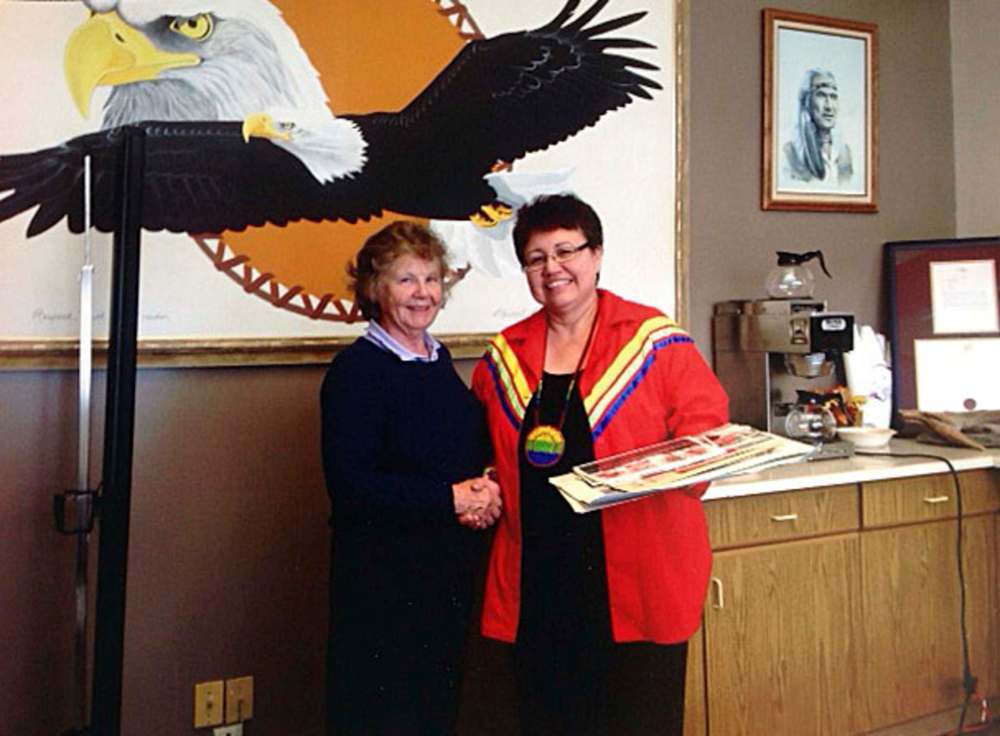
“As somebody who at a young age had also been told I wasn’t allowed to speak my own language I always felt a kinship with the Indigenous people, so how could I have said no?” she says, noting her late husband felt the same way. “Like many of the people we got to know up there, he was sent to a residential school in Wales as a kid, where he wasn’t allowed to speak Welsh. He was very angry about having lost much of his culture at so early an age, so it was easy for him to empathize.”
Clendenan learned in December that her mother was preparing to come out of retirement again, this time to assist with Manitoba’s COVID vaccination program.
“No surprise there; I am very pleased she put herself forward. Her observational skills with patients would be so valuable in this particular situation,” Clendenan says, adding she’s most proud of the work her mother did with children with cleft palates, transplant patients and AIDS patients. (Did we mention that when most dentists in Manitoba were refusing to treat people afflicted with the human immunodeficiency virus (HIV) Odlum said, in so many words, move over, she would do it?)
“Plus, her work with the northern communities was just part of both my parents’ working lives; they were both empathetic to those people’s lost control of their being, and the government interference in their way of life. My parents could talk with them with the undeniable understanding of having a government think they knew better than the Indigenous people of the land.”

About that; in January 1992 a film crew from S4C, a Welsh-language television station, flew to Canada to put together a documentary on Odlum’s storied career. The first part was filmed at her house, next they shot at the university where students were being prepped for their trip north.
“Next the fight to Churchill, then to Arviat in Nunavut where we were filmed treating a patient,” Odlum says, believing the title of the completed film, (she has a copy in one of her drawers) was “something dumb” like Dentist to the Eskimos. “Whenever I used to tell my mum about what I was up to she’d be, oh, there you go again. Except when they did the movie and I went home for the première, she took me to church to show me off to all her friends. That was lovely.”
david.sanderson@freepress.mb.ca
Dave Sanderson was born in Regina but please, don’t hold that against him.
Our newsroom depends on a growing audience of readers to power our journalism. If you are not a paid reader, please consider becoming a subscriber.
Our newsroom depends on its audience of readers to power our journalism. Thank you for your support.
History
Updated on Friday, April 2, 2021 9:58 AM CDT: Fixes name in pullquote.
Updated on Saturday, April 3, 2021 1:21 PM CDT: Corrects cutline in photo of Odlum and former Peguis chief.

